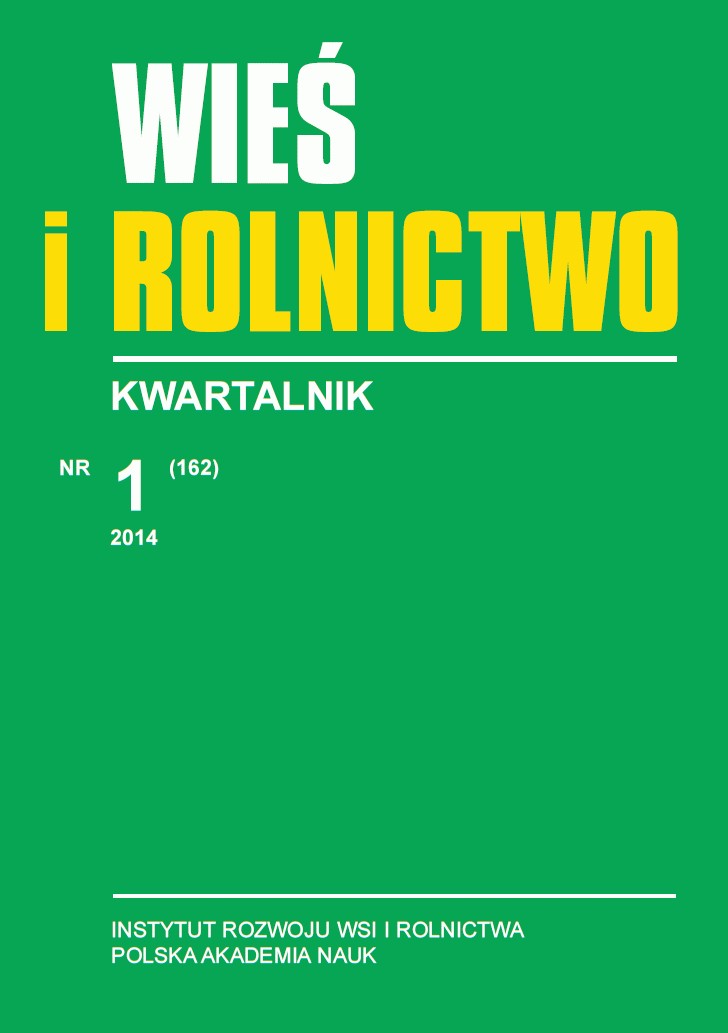The structure of contemporary Polish rural society. Regional diversity
DOI:
https://doi.org/10.53098/wir.2014.1.162/04Keywords:
structure social, structure social-vocational, structure education, structure incomem, regional diversityAbstract
This sketch presents the structure of rural society. It concentrates on three aspects of the rural social condition: the social-vocational structure, the educational structure (indicating qualification levels) and the revenue structure. The latter is one of the most important factors determining a person's place in the hierarchy of consumer society. The empirical data base is derived from research and the analysis of the Diagnoza społeczna 2009 [Social Diagnosis 2009]. In this year, research was conducted on a representative sample of 12 381 households, comprising 37 841 people. In this a rural sample comprised 4079 households (33%), and included 38.7% of the total sample population. The diversity of rural society has been presented on a nationwide scale and in two regional cross-sections: according to administrative-political regions, or voivodships, and according to the historical regions formed in the 19th and 20th centuries. This second cross section shows Polish territory that was under the control of various partitioning powers in the 19th century and the territories assigned to Poland after the Second World War (formerly known as the “Recovered Territories”).References
Czapiński J., Panek T. (red.), 2009: Diagnoza społeczna 2009. Rada Monitoringu Społecznego, Warszawa.
Domański H., 2004: Struktura społeczna. Wydawnictwo Naukowe „Scholar”, Warszawa.
Domański H., 2011: Empiryczny test hipotezy o pękniętej strukturze społecznej. [w:] Co się dzieje ze społeczeństwem?, M. Flis, K. Frysztacki, G. Skąpska, P. Polak (red.). Wydawnictwo Uniwersytetu Jagiellońskiego, Kraków.
Frenkel I., 2011: Zatrudnienie i bezrobocie na wsi w latach 2006–2009. [w:] Rozwój obszarów wiejskich w Polsce. Diagnozy, strategie, koncepcje polityki, I. Nurzyńska, M. Drygas (red.). IRWiR PAN, Warszawa.
Giddens A., 2004: Socjologia. Wydawnictwo Naukowe PWN, Warszawa.
GUS, 2010a: Budżety gospodarstw domowych w 2009 r. Warszawa.
GUS, 2010b: Aktywność ekonomiczna ludności Polski. IV kwartał 2009. Warszawa.
Halamska, M., 2011: Transformacja wsi 1989–2009: zmienny rytm modernizacji. Studia Regionalne i Lokalne nr 2, s. 5–23.
Halamska M., 2011a: Rolnicy między upośledzeniem a przywilejami. [w:] Polacy we wspólnej Europie, M. Jarosz (red.). ISP PAN, Warszawa, s. 141–159
Halamska M., 2013: Wiejska Polska na początku XXI wieku. Rozważania o gospodarce i społeczeństwie. Wydawnictwo Naukowe „Scholar”, Warszawa.
Słomczyński K.M., Janicka K., 2008: Dychotomie w strukturze klasowej: o efekcie św. Mateusza i pogłębiających się nierównościach społecznych. [w:] Co nas łączy, co nas dzieli, J. Mucha, E. Narkiewicz-Niedbalec, M. Zielińska (red.). Polskie Towarzystwo Socjologiczne, Uniwersytet Zielonogórski, Zielona Góra.
Zegar J., 2008: Z czego żyje polska wieś? [w:] Polska wieś 2008. Raport o stanie wsi, J. Wilkin, I. Nurzyńska (red.). Fundacja na rzecz Rozwoju Polskiego Rolnictwa, Warszawa, s. 11–26.
Załącznik do rozporządzenia Ministra Pracy i Polityki Społecznej z dnia 10 grudnia 2002 r. w sprawie klasyfikacji zawodów i specjalności dla potrzeb rynku pracy oraz zakresu jej stosowania. (Dz.U. nr 222, poz. 1868).
Downloads
Article file downloads
Pages
How to Cite
Issue
Section
License
Copyright (c) 2014 Wieś i Rolnictwo

This work is licensed under a Creative Commons Attribution 4.0 International License.






